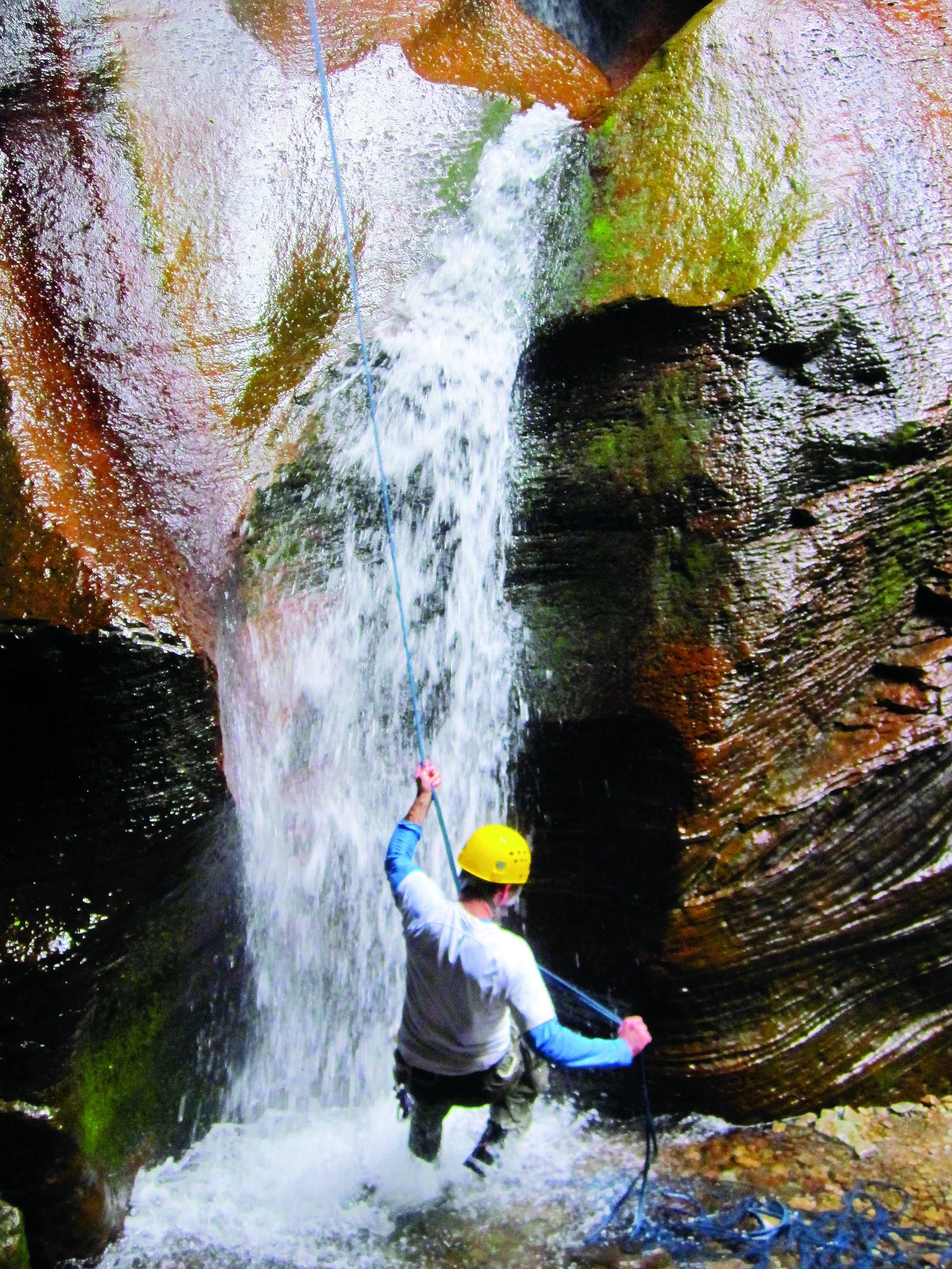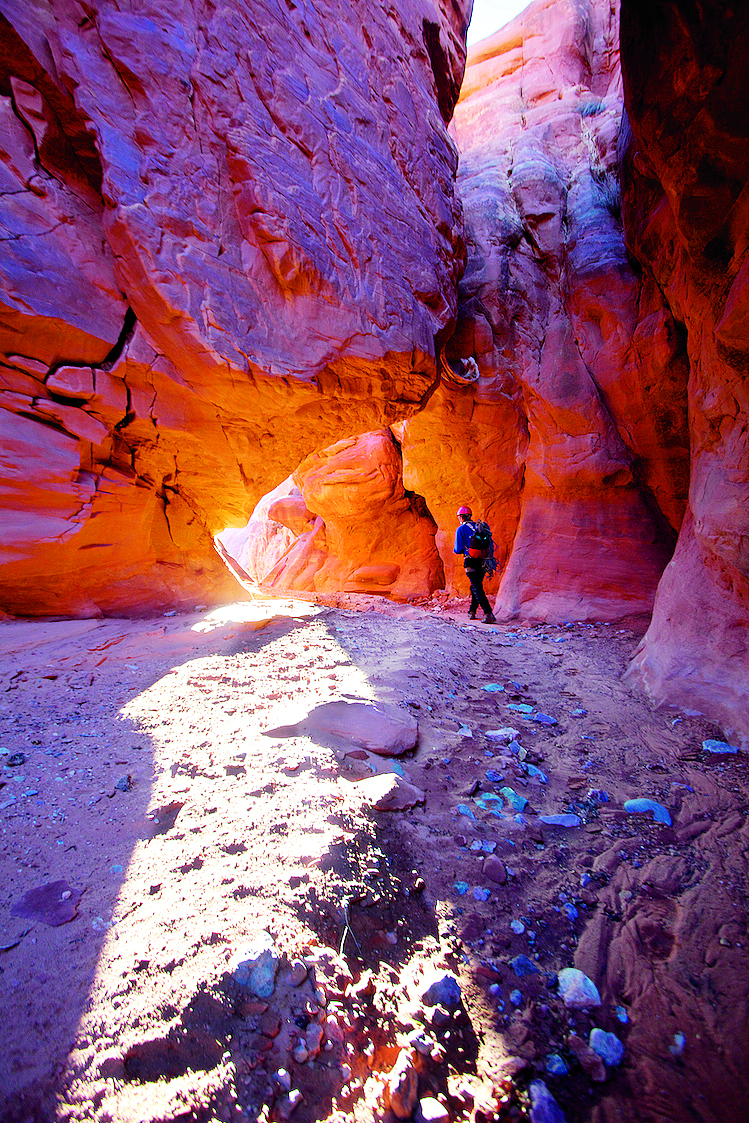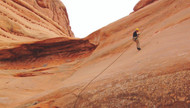The Ultimate Canyoneering Gear List | Excerpt from Moab Canyoneering
Posted by Derek Wolfe on 11th Mar 2024
Canyoneering is a dangerous sport where serious injury or death can occur. This is a gear list and not a how-to instructional or safety guide. You are responsible for your own safety and judgment.
As with any sport, canyoneering requires gear. After the initial investment, canyoneering can be a relatively cheap hobby. Simply put, canyons are hard on gear and gear will have to be replaced. Purchasing specialized canyoneering gear, such as ropes, shoes, and packs can make gear last longer.

Personal Gear
Each individual in the party should have all their own individual gear. This includes:
Packs – Canyoneering is hard on packs and cheap backpacks will wear out quickly. Usually a small-medium sized day pack will suffice. Specialized canyoneering packs feature reinforced edges and bottoms and last much longer. Usually, external pockets and items sticking out of the pack will wear out quickly. Hard items such as water bottles or carabiners, if left on the edges of packs, can quickly wear holes into the pack. A normal backpack can be reinforced with patches of Shoe Goo® or rubber cement to increase the durability of a pack. If descending a wet canyon, grommeted packs that can easily drain are desired. For shorter trips, I personally prefer the Lost Creek caving pack with ballistic nylon reinforced with Shoe Goo®.
Drybags/Kegs – Descending a wet canyon will require a drybag or keg to keep electronic items, paper and extra clothing dry. Drybags are usually made of a coated nylon and are highly water resistant but are not totally waterproof. To avoid wear, drybags should be placed in a pack. Kegs are a hard plastic shell and are waterproof but can be bulky. The advantage of a keg is that items inside are more easily accessed and will not be crushed. Along with empty water bottles, a drybag can be filled with air to help aid in floatation while swimming. Electronic devices can be placed into smaller plastic containers such as Pelican cases.

Technical Gear
While each canyon is different, the general standard technical gear for each individual should include:
Helmet – Some people don’t believe a helmet is an absolutely necessary piece of gear but it really is required. A helmet can protect your head from falling objects such as rocks, carabiners and any other objects gravity decides to pull down. Blunt force traumas from falls due to slick conditions and tricky downclimbs can also be minimized. A helmet has saved my life when I took an 18-foot ground fall while climbing. Landing directly on my head, the helmet cracked and I walked away with only a small laceration. The best helmets for canyoneering are any UIAA rated climbing helmet. Things to consider when looking for a helmet are comfort, ventilation, ease of adjustment, headlamp attachment and durability.
Harness – Any durable harness offering all day comfort while hiking should do the trick. Considerations for a harness are gear loops for extra carabiners, Prusik cords and rappelling devices, a belay loop and adjustable leg loops. Some canyons require shorts while others require thick wetsuits so adjustable leg loops are best. Tight slots have a tendency to wear out leg loops quickly and can wear down edges of the harness quickly.
Rappelling Device – Without a doubt, there is no shortage of different styles of rappelling devices. Specialized canyoneering rappelling devices such as the Sterling ATS or The Totem work in a variety of situations but can be expensive. Standard figure eights and ATCs can work just as well. Due to the variety of rappelling techniques and rope diameters, a device that can add/decrease friction, and is compact and lightweight would be an ideal choice. Each device has its own advantages and disadvantages and everyone in the party should know how to work their specific device.
Carabiners – A minimum of 4-6 locking carabiners plus 2-4 non-locking carabiners should be carried by each individual. Screw gate carabiners work better than the “auto lock” carabiners as sand can gum up the locking mechanism on the latter. Anytime wear on a carabiner, such as rappelling grooves or large nicks are noticed, the carabiner should be retired. Serving many purposes such as safety tethers, anchoring, rappelling, pack tethers, guided rappels, etc, it seems one can never have enough carabiners.
Personal Tether – This can include a personal anchor, daisy chain, runner or webbing loop. Personal tethers can be used as safety lines into anchors for security when inspecting a rappel or for hanging a pack while stemming. Any time your life is dependent on the tether a locking carabiner should be used.
Ropes – There are two main types of ropes—static and dynamic—both of which can
be ued for canyoneering. Rope diameters vary from 8mm to 11mm with standard
lengths of 50 meters and 60 meters. Smaller diameter ropes are lighter weight but
offer less friction during rappels and have less durability. Due to this factor, 8 mm
ropes are generally used by experienced canyoneers. Most people use a mid-range
diameter of 9 mm to 10 mm.
Static ropes or ropes with very little stretch are preferred for canyoneering since
most canyoneering rope work involves rappelling. Furthermore, static ropes create
smoother rappels and are more resilient to abrasion. Specialized canyoneering
ropes use tightly woven fibers which increase durability.
Dynamic ropes, primarily used by rock climbers, stretch to absorb energy during
a fall. If using a dynamic rope for canyoneering it’s highly recommended that the
rope is not used for lead climbing again due to sand and grit working into the inner
fibers of the rope, thus decreasing their strength. Since dynamic ropes stretch,
extra care should be used to make sure they do not rub on edges during rappels.
For any rappel, the rope must be double the length of the descent. This may
include the length of the rope and a pull cord. Double 60 meter ropes will allow
anyone to descend any canyon in this book. Most experienced canyoneers will
rappel single strand using a biner block at the anchor and a pull chord to retrieve
their rope thus minimizing weight.
Ascending Gear – Often neglected, ascending gear should always be packed
by at least one member of the party. If high friction causes rope pulling to be
difficult, ascending gear can provide extra leverage; and if a rope becomes stuck,
a canyoneer can re-ascend the rope to fix the pull. Before re-ascending a rope, the
safety of re-ascending the rope should be evaluated. Additionally, ascending gear
can be used in more technical canyons that have deep potholes.
Many varieties of ascenders exist from simple Prusik cords to mechanical ascenders.
Prusik cords can be lightweight but lack the efficiency of heavy mechanical
ascenders. Tiblocs and smaller ascenders such as the Petzl Basic and Croll can
make a good compromise between weight and efficiency. The best way to avoid using ascending gear is good rope management by using well-placed anchors that minimize friction on the rope pull. Always check rope pulls before the last person rappels down.
Slings/Webbing – Enough webbing should be taken to replace all anchors. A canyon with more rappels will require more webbing. Always evaluate all anchors and do not be hesitant to replace an anchor. All anchors should be suspect until fully evaluated. The most popular choice for webbing is 1 inch tubular webbing in a color that blends into the canyon environment. Rust, sand, brown and black are fairly common colors.
Rapid Links, Quick Links – To avoid wear on slings and webbing, rapid links and quick links should be used on all anchors. It doesn’t take long for a rope to “saw” its way through webbing. Take enough rapid links and quick links for each rappel in the canyon. The most common sized quick links are 5/16 inch. Rusted or damaged quick links should be replaced.
Emergency Bolt Kit/Hooking Kit – For all of the canyons in this book, a bolt kit is NOT required. This item should be left at home.
Clothing - The temperature in canyons can drastically change. Temperature swings can be as much as 40 degrees Fahrenheit between the day and night. While some canyons may only require shorts and t-shirts, others will require more insulation or a wetsuit. Non-cotton clothing should be used in dry canyons and extra layers should be used when required. Be prepared by anticipating low temperatures.
Wetsuit – Wetsuits provide insulation and abrasion protection. Depending on the canyon a wetsuit might be advisable or required to help prevent hypothermia, especially in C rated canyons. The time of year, depth of canyon, time exposed to water and outside temperature may dictate the type and thickness of wetsuit needed. Thick 5 mm long sleeve wetsuits might be required in longer wetter colder canyons while 3-4 mm shortie “farmer john” wetsuits may be used in hot weather or in canyons with less water exposure.
Gloves – High quality leather gloves or gardening gloves will work. The main objective is to provide some protection to your hands from the abrasive sandstone. Also, gloves can save wear on your hands during rappels. Gloves should not be used as a “breaking” source while on rappel; use an adequate diameter rope.
Socks – Regular hiking socks can be used in dry canyons while neoprene socks may be advised in wetter canyons. A second, lighter pair of socks could be used for the approach hike since neoprene socks can be hot and uncomfortable. The most common thickness of neoprene socks is 2-3.5 mm.
Footwear – Specialized canyoneering shoes, like the Five Ten Canyoneer, are highly recommended but any sturdy footwear can be used. Good footwear should be comfortable for hiking, good for climbing and able to be used while wet. Leather boots should be avoided in wet canyons as they tend to be heavy and are more prone to abuse. Canyoneering shoes are designed with sticky rubber that can be used for both aquatic and non-aquatic use, are excellent for hiking and climbing, and provide all around durability.

